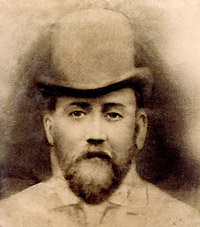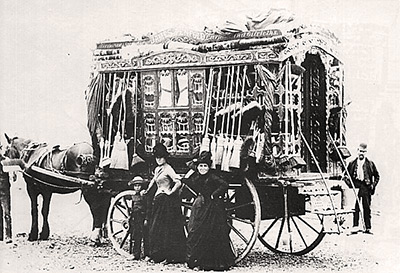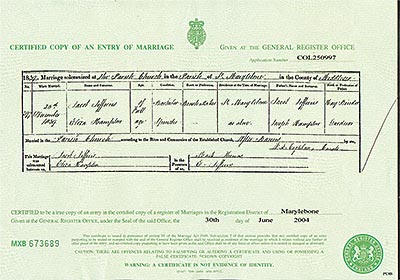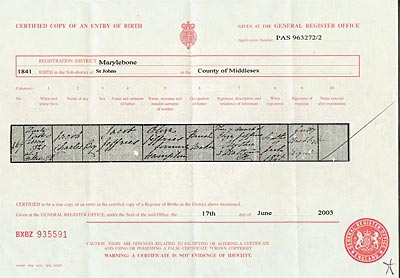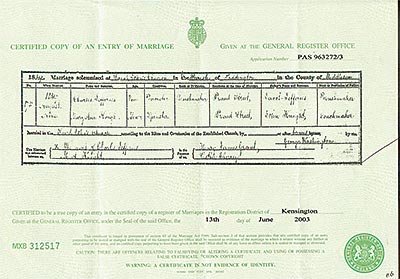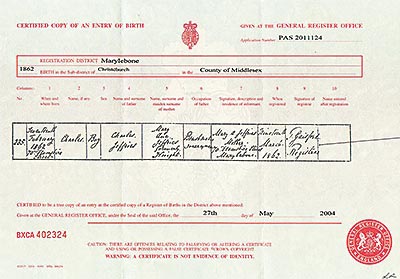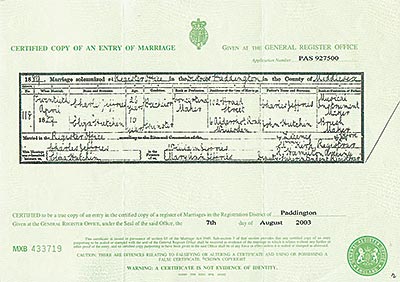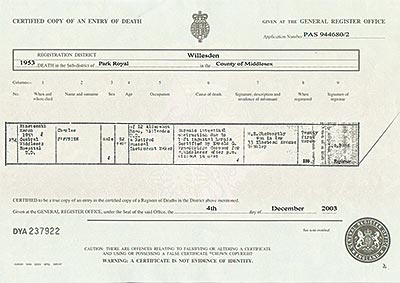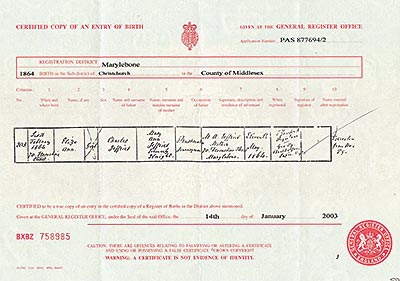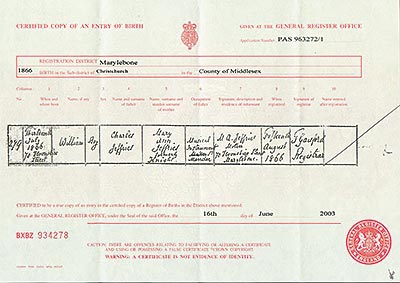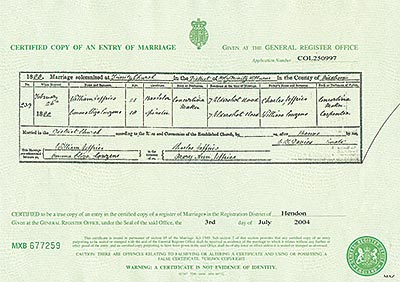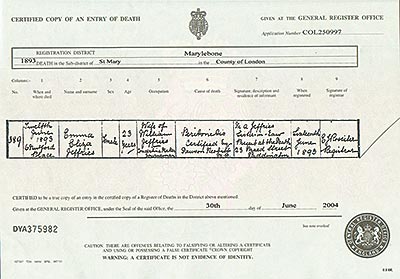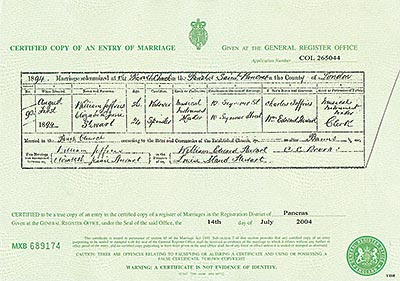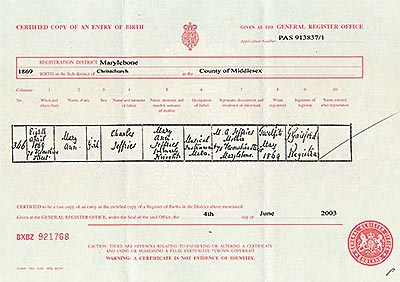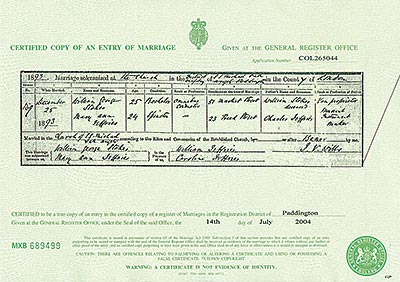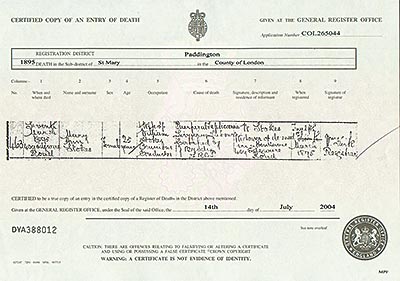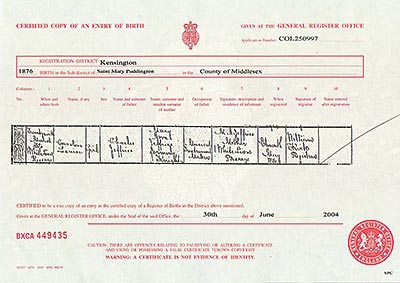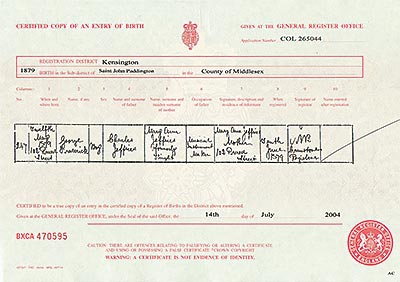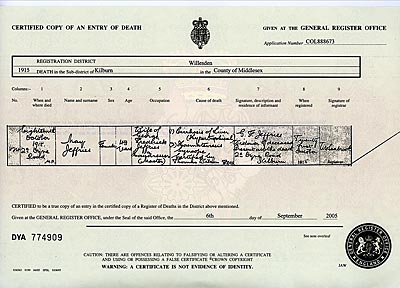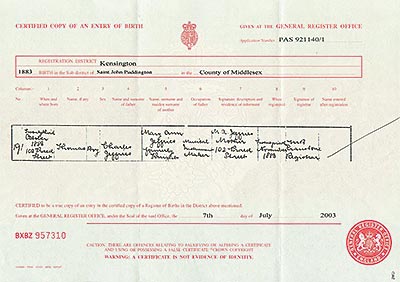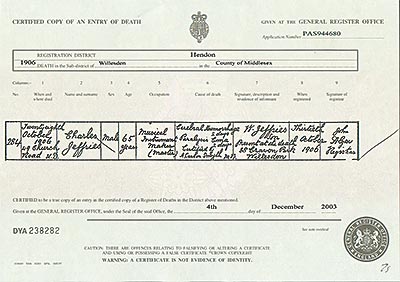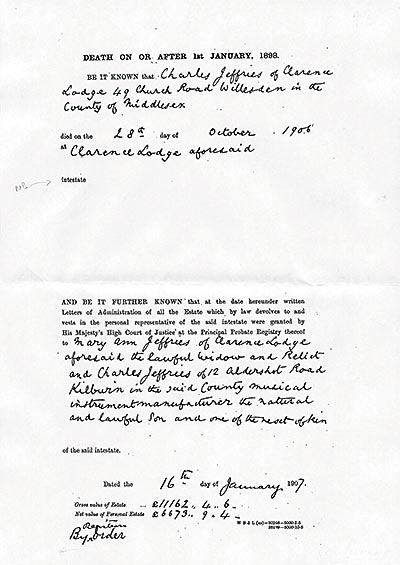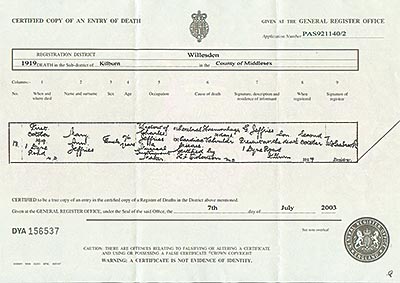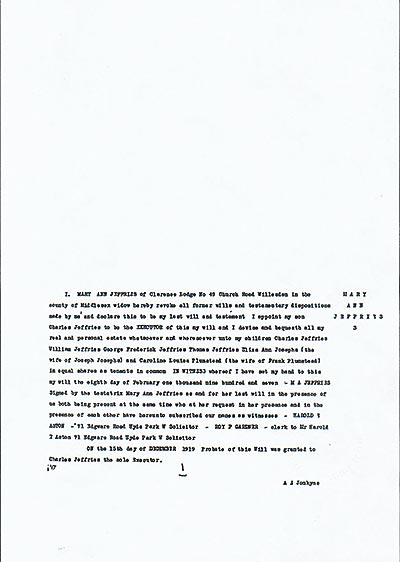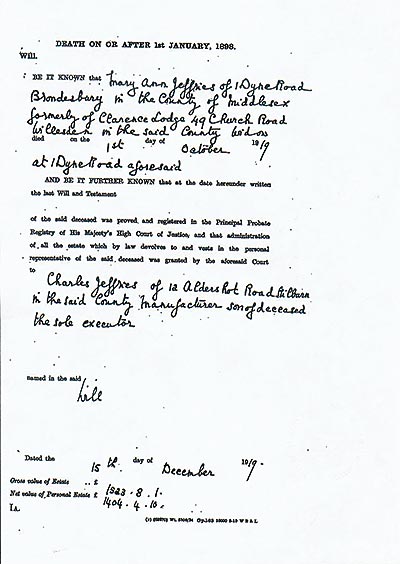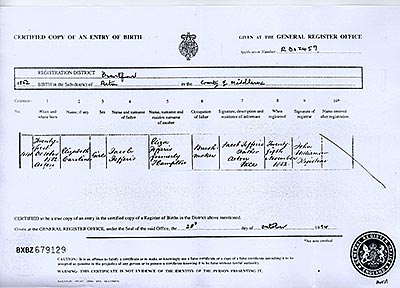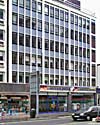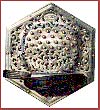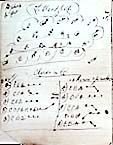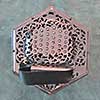Charles Jeffries: the Man and His
Family1
Charlie Jeffery was a tinker, in the 1870s, who used to go round with a barrow
mending pots and pans. When he didn't get any tinkers' work, he used to busk on
the concertina: People would say ‘we like that, can you get us one made?’—so
that’s how he got started.
—Harry Crabb, interviewed circa 1970
Typical of the enigmatic fame of Charles Jeffries is the fact that no photographs
of him were publicly known until mid-2005, when photographs of Charles Jeffries and of his wife
Mary Ann were made available by Mrs. Pearl Pierce née Pearl Jeffries, a granddaughter.
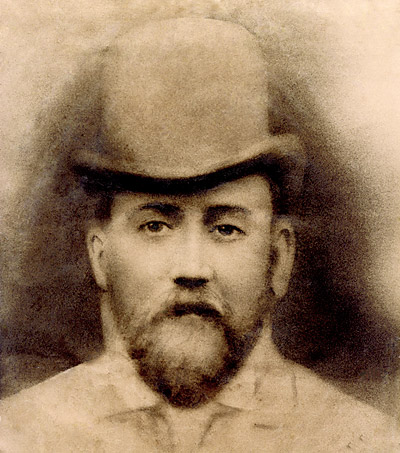
Charles Jeffries, circa 1875
Courtesy of Mrs. Pearl Pierce
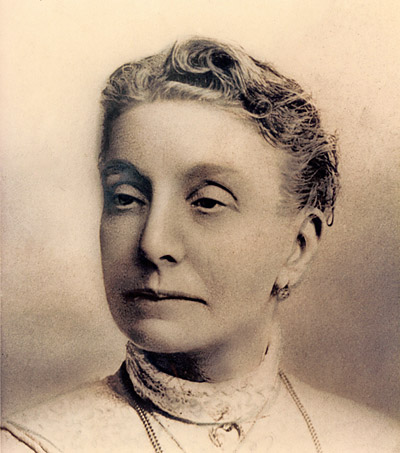
Mary Ann Jeffries, circa 1910
Courtesy of Mrs. Pearl Pierce
Pearl Pierce’s older sister, Pamela Forsey, remembers both these photographs
of her paternal grandparents being on the
wall of the George Jeffries house when she was a little girl (around 1930), both pictures in gold frames
and appearing to be gigantic. (This may account for the unusual appearance of the background
in the photograph of Charles—a small carte de visite photo taken many years before
may have been enlarged and its background artistically augmented to make a match to the
larger and later studio portrait of Mary Ann.)
Two perspectives have been offered about the early career of Charles Jeffries.
According to legend, Charles Jeffries was a “tinker”—a person who mends pots and pans,
sharpens knives, and deals in various scrap metal objects. Descendants in the Jeffries
family adamantly contended that Charles Jeffries was a brushmaker in his younger days,
and this turned out to be true. We now know that his father,
Jacob Jeffries, was a brushmaker and that Charles Jeffries was apprenticed
to the trade, which would have happened when he was about 12 years old.
His father almost certainly would have been the Master of his apprenticeship,
which would have lasted for 7 years. After his apprenticeship, (completed about the time of
his marriage in 1859), Charles would have become a member of the the Society of Brushmakers.
The Society of Brushmakers
Brushmaking was an honourable profession which had a well organized structure dating back to the mid-18th
century (original chapter in Manchester, 1747) . The Society of Brushmakers/Journeyman, which
apparently was a closed and secretive organization (complete with a secret five-tone tune), had branches
all over England, and members paid a weekly contribution. The Society organized ‘price agreements’ between
Master and Journeyman, and these were regularly updated. The Society of Brushmakers is sometimes called the
first “trade union” in England, even though “trade union” connoted “conspiracy,” and the Society itself was
illegal. Ironically, the members who abided by the Society rules were called “legal masters,” their apprentices
were “legal apprentices,” and their shops were “legal shops.” A member who could not find work in his locality
could “tramp the circuit” to find employment in the next town in which the Society had a branch (44 towns). If
no employment could be found, the member would be provided with traveling money and food and lodging at
modest prices as he moved to the next town on the designated circuit. Upon completing the 1,210 mile circuit
and presenting a properly filled “Blank”—a book showing branch secretaries’ signatures for all stops on the
circuit—the unemployed journeyman qualified for unemployment benefits.
Society of Brushmakers’ Descendants website:
www.brushmakers.com
But brushmaking could also be an itinerant occupation, with the brushes being made during the winter
and hawked through the summer. There were even caravans called “brush wagons” used by such travelling
brushmakers, so there might be grounds for the Crabbs to consider the brushmaker Charlie Jeffries as a
“tinker”.
Charles probably acquired his first concertina in the early 1860s. One scenario is that
he may have joined in playing music at the conclusion of Society of Brushmakers meetings. Another legend
of his early life has him traveling with his barrow and playing his concertina to attract the
attention of people in the surrounding houses or busking for pennies when business was
quiet. When people became interested in his concertina, he would offer to sell them one. If
the story has any truth, most of his early customers would have been ordinary
folks, not those from the higher circles of society in which Wheatstone English-system
concertinas were the norm.
Somehow his skills eventually led him to the concertina as a trade,
apparently first as an aspiring concertina player, then
as a repairer, and finally as a maker. In the 1861 census, Charles gave his profession as
“musician”. The following year, he was back to brushes, being listed as “brushmaker
journeyman” in 1862 on the birth certificate of his first son, and “brushmaker journeyman” again in 1864 on the
birth certificate for his first daughter. In the 1866 birth certificate for the next child,
his occupation is given as “musical instrument maker” but the “maker” is struck out and corrected
to “mender”. But by the fourth child's birth certificate, 1869, his occupation is “musical
instrument maker”. This is good evidence that Charles Jeffries
went into the concertina trade in earnest in the mid-1860s to late-1860s.
II. The Jeffries Family
II.A. Charles Jeffries (1841–1906) and Mary Ann Jeffries (died 1919)
Jacob Jeffries and Eliza Hampton, the parents of Charles Jeffries, had been married
on Christmas Day in 1839 at the Parish Church of St. Marylebone, Middlesex.
Jacob Jeffries (born 1818) was a brushmaker originally from the Seend/Semington area of rural Wiltshire,
and his father, also Jacob Jeffries, was a "hay binder". Eliza Hampton (born 1818)
was the daughter of Joseph Hampton, a gardener.
(For each of the certificates below, you can click on the certificate
to see a larger and easily-read picture; then click again on the
large picture to return to the spot where you were reading.)
(In several public records for Jeffries family members, such as this one, Jefferies rather than Jeffries
appears as the surname. Charles Jeffries’s father and/or grandfather might have used the
alternative spelling. Equally likely, incidents of the Jefferies spelling were recording
errors by registrars or census takers. In the 1861, 1871, and 1881 census transcripts,
Jefferies is shown for the Charles Jeffries household; in the 1891 and 1901 census records,
Jeffries is shown.)
Their son Jacob Charles Jeffries (known as Charles Jeffries) was born on May 31, 1841 at
No. 3 Hatton Place (just off the Edgware Road and about 300 yards from Praed Street),
Marylebone, Middlesex. We have not yet systematically researched other members of
Jacob and Eliza’s household, though we know that Charles had a younger
sister.2
By the time of his own marriage at age 18, Jacob Charles Jeffries already had dropped the Jacob in
favor of using Charles as his given name. His bride was Mary Ann Knight
(born 1843 in Devonshire), daughter of coachmaker John Knight.
The wedding was held on August 9, 1859 at St. Johns Church, Brunswick Crescent, Paddington, London.
Charles and Mary Ann
set up housekeeping at No. 70, Devonshire Street, Marylebone, Middlesex.
On his marriage certificate, Charles Jeffries's signature is represented by an "X"
followed by "The mark of Charles Jeffries" (while Mary Ann signs her name in the ordinary way).
This argues strongly that Charles Jeffries had no formal education at all, and accounts for
why we should not expect to find a mountain of written records from his business.
II.B The Children of Charles and Mary Ann Jeffries
Charles and Mary Ann had four sons and three daughters:
- Charles jnr (born 17 February 1862),
- Eliza Ann (born 6 February 1864),
- William (born 13 July 1866),
- Mary Ann (born 8 April 1869),
- Caroline Louisa (born 29 March 1876),
- George Frederick (born 12 May 1879),
and
- Thomas (born 23 October 1883).
(Throughout this article, we use “Charles Jeffries” to refer to Jacob Charles Jeffries,
the father, and we use “Charles Jeffries jnr” to refer to the son, Charles Jeffries.
The son has been informally dubbed “Charles jnr” in some discussions, but
we have no evidence that he ever used any form of “Junior” as part of his name.)
The family resided at No. 70, Devonshire Street at least through April 1869 (birth of Mary Ann).
They had moved to No. 1 White Lion Passage by the time of the census in April 1871,
and were still residing at the White Lion Passage address in May 1876,
when Mary Ann registered the birth of Caroline Louisa.
By the time of George Frederick’s birth in 1879,
they had moved again, to 102 Praed St., Paddington, Middlesex. In the 1881 census, sons Charles jnr (age 19),
William (age 14), and George (age 1) and daughters Eliza A. (age 17), Mary Ann (age 11),
and Caroline (age 5) were living with their parents at 102 Praed Street, London (Paddington, Middlesex).
Thomas had not yet been conceived.
By 1891, they had moved to 12 Aldershot Road, Kilburn.
The 1891 census shows Charles and Mary Ann, with five children: Eliza (age 27), Mary Ann (age 21), Caroline
(age 15), George (age 11), and Thomas (age 7) then residing at 12 Aldershot Road, Kilburn.
By the time of the 1901 census, Charles and Mary Ann had moved to Clarence Lodge, 49
Church Road, at the corner of Taylors Lane and Church Road in
Willesden. (The Church Road neighborhood was dominated by residences of the professional class.
Clarence Lodge later became a working man’s club and, about 1970, was demolished when Church Road was widened.)
In 1901 only two children were still living with their parents:
George (age 21) and Thomas (age 17).
Known Descendants of Charles and Mary Ann Jeffries
- Jacob Charles Jeffries (1841-1906) married Mary Ann Knight (1843-1919) in 1859
- Charles Jeffries jnr (1862-1953) married Eliza Hutchin (c.1870–1949) in 1889
- Beatrice Rose Jeffries (1890-1974) married Albert G. Counsell in 1921
- Ada Louise Jeffries (born 1891) married Alec Jonathan Squibbs
- Charles C. Jeffries (1895-1917)
- Maud Mary Ann Jeffries (born 1897) married William Clatworthy
- May Mary Ann Jeffries (born 1899)
- Alice Eliza Jeffries (born 1901) married George W. Peckett in 1931
- Sheila Peckett (born 1933)
- Dorothy Jeffries (born 1904)
- Daisy Jeffries (born 1906) m. Alfred Fogden
- Robert Fogden
- Suzanne Fogden (born 1957) m. Charles
- Ken Fogden
- Eliza Ann Jeffries (1864–1938) married Joseph Josephs
- Charles Josephs (born 1889)
- William Jeffries (born 1866) married Emma Eliza Couzens (born c. 1870) in 1888
and married Elizabeth H. J. Stewart (born 1870) in 1894
- William Earl Jeffries (born 1895)
- Mary Ann Jeffries (1869-1895) married William George Stokes in 1893
- Herbert Stokes (born and died 1895)
- Caroline Louisa Jeffries (born 1876) married Frank Plumstead
- Mary Ann Plumstead (born c. 1900)
- George Frederick Jeffries (1879-1965) married May (died 1915),
married Jessie Adams (died 1975) in 1921
- George Norman Jeffries (1922-2001)
- Pamela Jeffries m. Forsey
- Beryl ("Pearl") Jeffries (1929-) m. Pierce
- Thomas Jeffries (1883-1966) was married, divorced, and remarried
- Thomas Jeffries
- Nell Jeffries
- Olive Jeffries m. Pierce
Note: Charles and Mary Ann may have had one or more other grandchildren who have not been identified.
They probably had several other great grandchildren who are not shown.
II.B.1 Charles Jeffries jnr (1862–1953)
The first child, Charles Jeffries jnr, was born in 1862.
In 1889, Charles jnr married Eliza Hutchin (born 1870/71), the daughter of Ann Hutchin (born
c. 1816) and John Hutchin (born c. 1818). The bride's father was a brushmaker, as the groom's father
had been before getting into concertinas. The ceremony took place on 20 April 1889 at the
Register Office, Paddington. The couple established their residence at 16 Aldershot Road,
Kilburn, Willesden.
As of 1891, Charles jnr and Eliza were still residing at 16 Aldershot
Road, along with their infant daughters, Beatrice Rose (born March 1890) and a new baby.
The census taker visited in April 1891, just after the birth of daughter Ada Louise,
who had not been named and who was thus listed as “Baby” in the 1891 census.
By 1901, Charles jnr, wife Eliza, and their family—which by then had grown
to include son Charles C. Jeffries (born 1895) and daughters Maud and May—were living
at 12 Aldershot Road, where the elder Charles and Mary Ann had previously lived.
More daughters followed: Alice, Dorothy, and Daisy (one son and seven daughters in total). Charles jnr would
reside at 12 Aldershot Road for the rest of his life, except for a short hiatus
when 12 Aldershot Road was bombed in the blitz of World War II. (According to his granddaughter
Sheila Peckett, when he temporarily moved in with his daughter Alice Eliza during this period, he
turned up with all sorts of things, glue and boxes, probably to do with his instrument repairs.)
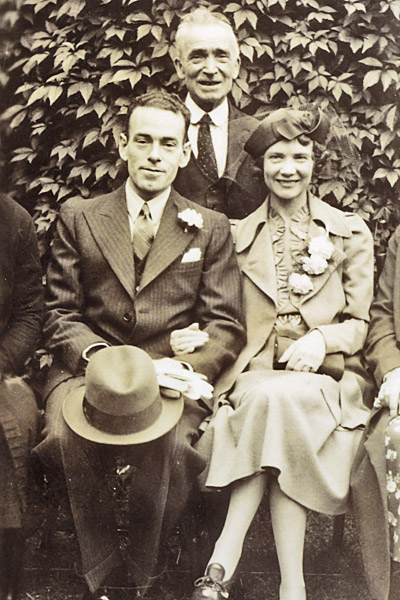
Charles Jeffries jnr (top) at wedding of daughter Dorothy, 1937
Courtesy of Sheila Peckett
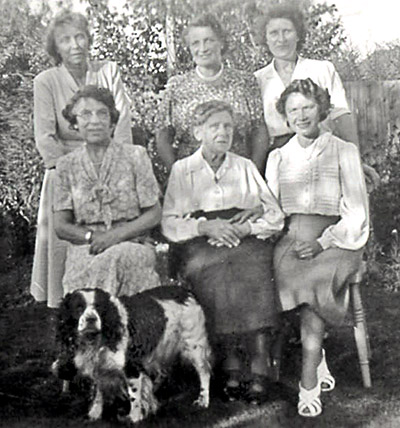
Eliza Jeffries (wife of Charles jnr) with five daughters, 1946–47
(back row, left to right: Daisy, Maud Mary Ann, Alice Eliza;
front row, left to right: Ada Louise, Eliza, Dorothy)
Courtesy of Sheila Peckett
Up to the time of his death at age 92, on 19 February 1953, Charles Jeffries jnr was still residing
at 12 Aldershot Road. His wife, Eliza, had died four years earlier. Charles Jeffries jnr, like
his father, died without leaving a will. Son-in-law William Clatworthy was the informant on
Charles jnr’s death certificate, and daughters Ada Louise Squibbs and Maud Mary Ann
Clatworthy (each residing in Wembley, Middlesex) were named the administrators of his
estate.
Charles C. Jeffries, son of Charles jnr and Eliza, was killed in the war in France on
March 26, 1917. A rifleman in the London Regiment (London Rifle Brigade), 2nd Unit, 5th
Battalion, he was 21 years of age. He is buried in Bucquay Road Cemetery, Ficheux, in the
vicinity of Pas de Calais, France.
II.B.2 Eliza Ann Jeffries (born 1864)
The second-born child, daughter Eliza Ann, was born in 1864.
Eliza Ann by 1901 had married Joseph Josephs, a cloth trader, and had given birth to
a son—the first offspring in the third generation to be named Charles (born 1889).
Before World War I, Eliza Ann and Joseph Josephs moved to No. 11 Praed Street, where Joseph plied his
trade which at that time was given as “wardrobe dealer” (a seller of secondhand clothes).
II.B.3 William Jeffries (born 1866)
William Jeffries was born in 1866.
William married Emma Eliza Couzens (born c. 1870) on February 26, 1888,
at Trinity Church, Kilburn. Emma Eliza’s father, William Couzens, was a carpenter.
But Emma Eliza died on 12 June 1893, having succumbed to peritonitis.
William Jeffries remained a widower for little more than a year. On 1 August 1894,
he married Elizabeth (“Lizzie”) Harriet Jessie Stewart (born 6 June 1870) at St.
Pancras, near the 10 Seymour Street residence of her parents—father William Edward
Stewart, Clerk of the Royal Court of Justice, and mother Louise Maud.
In the 1891 census,
the occupation of Lizzie Stewart (age 20) is shown as “bookfolder” (also with the census
enumerator’s notation of “BookB” for bookbinder). The original bellows makers for Wheatstone
concertinas were bookbinders, who had the necessary skills for working the finely skived
leather, cardboard, and paper. According to legend, “Mrs. Jeffries” was the finest bellows
maker at the firm of C. Jeffries, Maker. It has always been assumed that “Mrs. Jeffries” referred to Mary Ann,
the wife of Charles Whether or not that is true, Lizzie Jeffries may possibly be a “Mrs. Jeffries” who should
receive acclaim for bellows-making.
William and Lizzie set up housekeeping at 10 Manor Place, Paddington (adjacent to
the green), where son William Earl Jeffries was born on May 15, 1895. By 1901, William,
Lizzie, and William E. (age 6) had moved to 6 Lennox Villa, Church Road—opposite the
Charles and Mary Ann residence at Clarence Lodge.
(The structure at 6 Lennox Villa still stands, though renumbered and no longer known by its original terrace name.)
A daughter of George Jeffries, Pamela Forsey, recalls that William and his family
emigrated to either Australia or New Zealand. (We have not found a record of them there,
but we have heard of a Jeffries descendant from Australia visiting England about 15 years ago.)
The other daughter of George Jeffries, Pearl Pierce, has few recollections of William Jeffries,
whom she saw only during World War II. She remembers Uncle William as “an old man”,
which he would certainly have been by then (age nearly 75 when the war started).
II.B.4 Mary Ann Jeffries (1869–1895)
Mary Ann married William George Stokes, an
Omnibus conductor, on Christmas Day in 1893 and moved to 409 Edgware
Road, Paddington.
On 7 March 1895, Mary Ann died in giving birth to son Herbert, who did
not long survive.
II.B.5 Caroline Louisa Jeffries (born 1876)
Caroline Louisa had married Frank Plumstead, a packer of the Morning News, by 1901 and had given
birth to a daughter Mary Ann (born 1900/01), named in honor of the child’s grandmother and
late aunt.
II.B.6 George Frederick Jeffries (1879–1965)
George Frederick Jeffries was married presumably some time early in the new century, but we have
not managed yet to find a marriage certificate for his first marriage. We do know that the marriage was
childless and that his wife May died 21 October 1915 at 2c Dyne Road, Kilburn.
May was 43 at time of her death, so she had been born
around 1872 and was thus a few years older than George.
May's death certificate lists the widower, George
Frederick Jeffries, as a "hairdresser (master)". According to his daughter Pearl Pierce, George was wounded
in World War I and, after leaving the army, never again engaged in activities associated with concertinas.
George, after his first wife’s death, seems to have lived with his mother at No. 1 Dyne Road, close
to where he had lived with May. After his mother’s death in 1919, he
moved to 135 Portsdown Road, Paddington and
married Jessie Adams (born c. 1891) on 19 October 1921. Jesse’s parents were Thomas
Adams (born c. 1866), a plasterer, and Mary Ann Adams (born c. 1866). George and Jesse’s
first child, George Norman, was born on 20 January 1922. A daughter, Pamela, was born in the years between 1922 and 1929.
Their youngest daughter, Beryl (or “Pearl”) was born in 1929.
George Jeffries did not return to full-time employment until the World War II years, when he worked in a
factory. (Pamela Forsey, George Jeffries's middle child, recalled in 2005 that her father “did not need to work”
in the 1920s, but his wealth took a tumble in the stock market crash after 1929.)
George Frederick Jeffries died on 28 April 1965 in the home of his son, George Norman, at 17
Craven Park. George Norman Jeffries, a retired Naval Officer, still resided at 17 Craven Park
at the time of his own death on 1 October 2001.
It would seem that concertina playing was not a part of the family heritage. Speaking much
later (in 2005) about their childhood in the late 1920s and 1930s, the two daughters of George Jeffries
(Pearl Pierce and Pamela Forsey) could not recall any concertinas associated with their relatives. Their
own father George had played the piano; he had owned a concertina, but it was inherited by their brother,
George Norman Jeffries, and was lost by the time George died in 2001. (And yet, despite George’s apparently
limited interest in concertinas, it was his household
where the unique photographs of Charles and Mary Ann Jeffries were preserved in their gold frames.)
II.B.7 Thomas Jeffries (1883–1966)
Thomas Jeffries we know mostly through the few strands of information about his
business activities that have been gleaned from his correspondence with concertina customers up to the early
1960s. Pearl Pierce remembers her uncle Thomas, but has no memories
of his concertina activities. She recalls that in his estate were tools that her late brother,
George Norman, inherited.
Thomas had a son, also Thomas, who was killed in World War II,
as well as two younger daughters, Nell and Olive (the latter still surviving in 2005).
Thomas’s wife left him, and he remarried later in life.
Thomas Jeffries died on 18 March 1966. Up until his
death, Thomas still resided at 5 Craven Park, along with his second wife (“R. M.”).
II.C The Deaths of Charles and Mary Ann Jeffries
Charles Jeffries died on October 28, 1906 at the Clarence Lodge
residence, age 65. His death, following a cerebral hemorrhage and a two-day coma, must have been a sudden shock to
the family. He died intestate, and wife Mary Ann and Charles jnr were named the administrators
of his estate. In the probate registry, Charles jnr was listed as “musical instrument manufacturer,
the natural and lawful son and one of the next of kin.”
Son William registered Charles’s death, recording his father’s occupation as “Musical Instrument
Maker (Master).” By 1906, William and his family had moved to No. 38 Craven Park,
Willesden—closer to his parent’s home than Charles jnr at 12 Aldershot Road.
Though Charles Jeffries did not leave a will, we have the registration for probate of his estate.
Remarkably enough, the probate registration shows the gross value of Charles Jeffries‘s estate at
£11,162, and the net value at £6,673. Using the concertina calculator
to translate historic values to their current equivalents, we can determine that the year-2000 value of
Charles Jeffries’s estate would be approximately gross £3.4 million, and net £2.0 million.
This would seem to be a considerable estate for a brush maker turned concertina maker.
Mary Ann Jeffries died thirteen years later, on October 1, 1919. On her death certificate, her address was
shown as No. 1 Dyne Road, Brondesbury, Middlesex, a residence shared with her widower son, George.
Mary Ann did leave a will, executed about three months after Charles’s death.
In her will, Mary Ann bequeathed equal shares of all her
property to her four sons and her surviving daughters, Eliza Ann Josephs and
Caroline Louise Plumstead. Charles Jeffries jnr—whose occupation was listed as
“Manufacturer” at the time of his mother’s death—was the sole executor of his mother’s
estate.
The probate registration for Mary Ann's estate shows a considerably smaller estate
than Charles left: gross of £1,523, net of £1,404, which according to the
calculator translates to current values of approximately
gross £175,000 and net £160,000.
The obvious explanation would be transfers to their children during the
years between the deaths of Charles and Mary Ann.
According to Sheila Peckett, granddaughter of Charles Jeffries jnr (great-granddaughter of
Charles Jeffries), there is a family vault in Paddington Cemetary in Willesden Lane not far from
Aldershot Road. The list of those buried there includes both Charles Jeffries and Mary Ann Jeffries,
plus four of their children: Charles jnr (and his wife Eliza), Eliza Ann, George (and both of his wives,
May and Jessie), and Thomas.
William, Mary Ann, and Caroline are not recorded there.
III. Jeffries Geography
Praed Street was an early hub of Jeffries family history. Praed Street is located
in central London, north of Hyde Park, running along the south side of Paddington Station.
It almost meets Marylebone Road and the Edgware Road, and is close to Marble Arch,
Oxford Street, and Regent's Park, as well as the consulting rooms of Sherlock Holmes
at 221b Baker Street. This is a very central location, convenient to
all of central London.
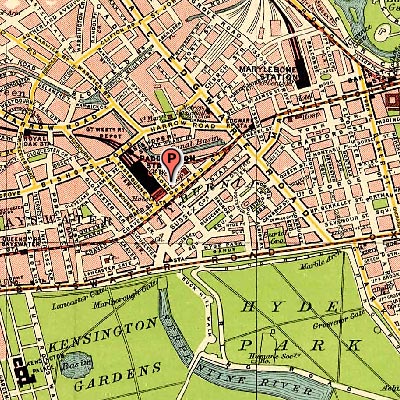
Praed Street ("P"), circa 1900
Charles was born in near proximity to Praed Street, and he and Mary Ann each lived in Praed Street before their
marriage. Two decades later, they returned to the locale, moving the family and the
concertina business to No. 102 Praed Street, a site on the north side of the street now occupied by the
frontage of Queen Marys Hospital, built in the early 1890s.
No. 23 Praed Street, on the south side of the street near the Edgware Road end,
became the premises of C. Jeffries, Maker in the early 1890s,
and then also served as a residence for Charles and Mary Ann’s daughters and their families.
Presumably, the Josephs and Plumstead families
resided upstairs, and the ground floor was devoted to concertina making and sales.
(At about the same time that the business moved to 23 Praed Street, Charles and Mary Ann had moved out
to 12 Aldershot Road.)
Before World War I, Eliza Ann and Joseph Josephs moved to No. 11 Praed Street, where Joseph plied his
trade which at that time was given as “wardrobe dealer” (a seller of secondhand clothes).
The early Jeffries location at “No. 1, White Lion Passage”, near Praed Street, has been the subject
of speculation for many years, because it had not been located on a map. Its location had
been known from the 1851 Post Office Directory to be off the Edgware Road, between Harrow Road
and Newcastle Place, both just north of Praed Street. The 1851 Directory gives “The White Lion” public house at
125 Edgware Road, Frederick and George A. Smith Proprietors, between an oil and colour man and a livery stable. (There
is another public house a bit further south at number 111, on the other side of Harrow Road,
called “The Red Lion”, so these are likely heraldic animals.)
By 1902, the directory lists “The White Lion” as still there, but
now owned by “The Metropolitan Theatre of Varieties, Ltd.” (Henri Gros, managing director),
renumbered to 267–269, Edgware Road. The pub is part of the music hall at the same address.
This 1872 map of Paddington clears up the mystery. By 1872, just about the time that Charles Jeffries was
setting up shop, the Metropolitan music hall had been completed, it
had incorporated “The White Lion” within itself, and a dog-leg passage labeled “White Lion Passage”
ran from that spot in the Edgware Road to Harrow Road, apparently opening on Harrow
Road. (We can't tell from the map whether the Passage continued to open directly onto the Edgware Road under some sort of
structure, or whether it was blocked by part of “The White Lion” through which access was provided.)
It connects to another interior street called “White Lion Place”.
Earlier maps of the same area back to 1827 show this same dog-leg passage, un-named, opening into both the Edgware Road
and Harrow Road.
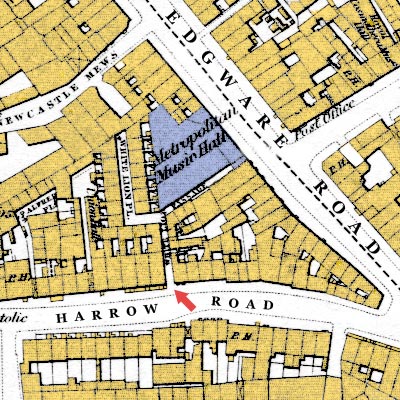
White Lion Passage (arrow), off Harrow Road, in 1872
This map does not indicate where along the passage “No. 1” was located, but Charles Jeffries
engraved "Edgware Road" along with "No. 1 White Lion Passage", and in the 1871 census enumeration
the entry for No. 1 comes right off of the Edgware Road. This suggests that Jeffries was located
at the Edgware Road end of the passage.
Aldershot Road, Kilburn, Willesden, was another center for the Jeffries family. Willesden is a suburb
developed along the Great Western Railway running northwest out of Paddington Station. Aldershot Road
is at the (eastern) Kilburn side, less than three miles from Praed Street up the Edgware Road.
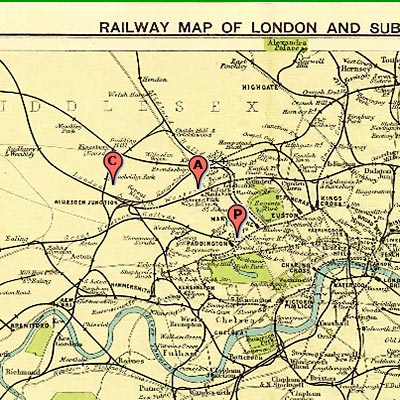
Praed Street ("P"), Aldershot Road ("A"), and Craven Park ("C"), circa 1900
In Aldershot Road, numbers 6, 7, 12, 14, and 16
were all connected to the Jeffries family:
-
No. 6 Aldershot Road was
the residence where Charles jnr’s bride, Eliza, and her parents—John and Ann Hutchin—were
living at the time of Eliza’s wedding.
-
No. 7 Aldershot Road was a short-time residence
of William Jeffries and his first wife, Emma Eliza.
-
No. 12 Aldershot Road was the home
address of Charles and Mary Ann in the 1890s and subsequently the home and business address
of Charles Jeffries jnr.
-
No. 14 Aldershot Road was occupied, at 1891 census time, by
Charles jnr’s father-in-law, John Hutchin—by then age 72 and retired from brushmaking—and
his second wife, Emma.
-
No. 16 Aldershot Road was the residence of Charles jnr and his family
until their move down the road to 12 Aldershot Road, as well as the home of William
Jeffries prior to his second marriage. At the time of the 1891 census, Charles jnr and family
occupied four rooms, and William and Emma Eliza, lived in three rooms at 16 Aldershot
Road.
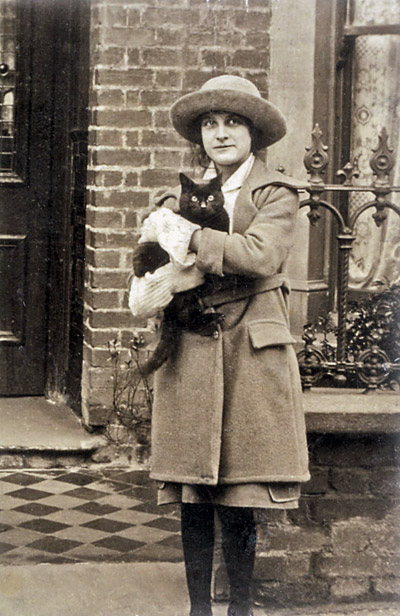
Alice Eliza Jeffries (granddaughter of Charles Jeffries)
and friend, in front of 12 Aldershot Road, circa 1914.
Courtesy of Sheila Peckett
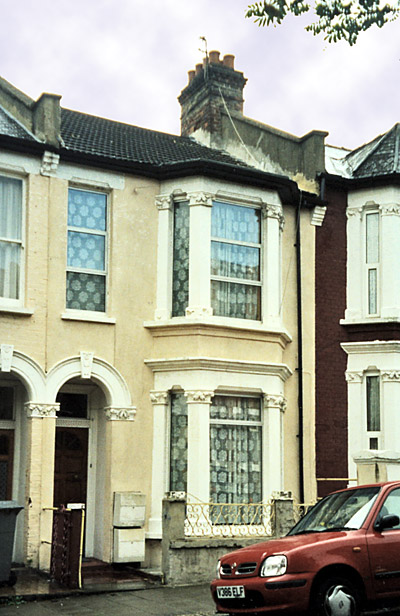
12 Aldershot Road today, as changed after repairs
made when a flying bomb hit the house opposite toward the
end of World War II, plus later modernization.
Courtesy of Sheila Peckett
Other properties were very close to Aldershot Road:
- No. 1 Dyne Road, where Mary Ann Jeffries died in 1919.
- No. 2c Dyne Road, where May Jeffries (first wife of George) died in 1915.
- No. 32 Torbay Road, where Eliza Ann Jeffries died in 1938.
A third focus of Jeffries geography was around Craven Park, Harlesden. This area is to the
west of Willesden, about three miles from Aldershot Road. Again, there is a concentration of
property:
-
49 Church Street, at the corner of Taylor's Lane, is a few blocks north of Craven Park, and was
home to Charles and Mary Ann Jeffries by 1901. Their children followed them in migrating toward
this neighborhood from the old Aldershot Road area.
-
38 Craven Park was where William Jeffries was living by 1906.
-
5 Craven Park was the last home of Thomas Jeffries, by the 1950s.
-
17 Craven Park was where George Jeffries died in 1965.
Known Addresses of Residences
of Charles and Mary Ann Jeffries and Their Children
- Jacob Charles Jeffries (Charles Jeffries)
- Birthplace (1841): No. 3 Hatton Street, Marylebone, Middlesex
- Mary Ann Jeffries (born Knight)
- Birthplace (1843): Devonshire
- No. 1 Dyne Road, Brondesbury, Middlesex (at time of death, 1919)
- Charles and Mary Ann Jeffries
- No. 70 Devonshire Street, Marylebone (1860s)
- No. 1 White Lion Passage, Edgware Road, Marylebone, Middlesex (by 1871)
- No. 102 Praed Street, Paddington (by 1879; 1880s)
- No. 12 Aldershot Road. Kilburn (1890s)
- Clarence Lodge, 49 Church Street, Willesden (by 1901; until time of death in 1906)
- Charles Jeffries [jnr]
- Birthplace (1862): No. 70 Devonshire Street, Marylebone
- No. 16 Aldershot Road (as of 1889; 1890s)
- No. 12 Aldershot Road (by 1900 until time of death in 1953)
- Eliza Ann Jeffries
- Birthplace (1864): No. 70 Devonshire Street, Marylebone
- No. 23 Praed Street (son Charles born here 1889, present in 1890s)
- No. 11 Praed Street (by 1914)
- No. 32 Torbay Road (death, 1938)
- William Jeffries
- Birthplace (1866): No. 70 Devonshire Street, Marylebone
- No. 7 Aldershot Road (as of 1888)
- No. 12 Aldershot Road (as of 1890)
- No. 16 Aldershot Road (as of 1893)
- No 10 Manor Place, Paddington (as of 1894)
- No. 6 Lennox Villa, Church Road (by 1901)
- No. 38, Craven Park, Willesden (by 1906)
- Mary Ann Jeffries
- Birthplace (1869): No. 70 Devonshire Street, Marylebone
- No. 23 Praed Street (as of 1893)
- 409 Edgware Road, Paddington (late 1893 until time death in 1895)
- Caroline Louisa Jeffries
- Birthplace (1876): White Lion Passage, Edgware Road, Marylebone
- No. 23 Praed Street (1890s onward)
- George Frederick
- Birthplace (1879): 102 Praed Street, Paddington
- No. 2c Dyne Road, Brondesbury, Middlesex (at time of first wife May’s death, 1915)
- No. 135 Portsdown Road, Paddington (at time of second marriage, 1921)
- No. 17 Craven Park (at time of death in 1965)
- Thomas Jeffries
- Birthplace (1883): No. 102 Praed Street, Paddington
- No. 5 Craven Park (1950s or earlier, until time of death in 1966)
(Addresses for children include only those at time of birth and those
after departing from their parents.)
Authors
Chris Algar
(
)
is a well-known expert on concertinas and their history. He is the proprietor of Barleycorn Concertinas,
maintaining the largest selection of concertinas of all types and buying and selling worldwide.
He has a particular interest in Ireland and Irish music, and supplies most of the concertinas played there.
He has been a collector for over thirty years, since first encountering concertinas
when he was a folk singer and Morris dancer. For most of that period he was also a
primary school teacher, but eventually had to give up teaching to spend all his time on concertinas.
Stephen Chambers
(
)
is a leading authority on the history of the concertina and a collector of early free reed
instruments; he has worked as a music librarian in London and was for many years proprietor
of the venerable John McNeill music store (est. 1834) in Dublin. He has recently moved to Kilrush,
Co. Clare, where he intends to set up a concertina and squeezebox museum with his collection,
and to start manufacturing concertinas.
Robert Gaskins
(
)
has studied and taught the use of computers for research
in the humanities and linguistics, and is co-author of a
textbook on computer programming for students of
languages, literature, art, and music. He has also
managed the computer science research section of an
international telecommunications R&D laboratory,
invented a graphics application program and led a startup
enterprise to develop it, and headed the Silicon Valley
business unit of a personal computer software company. He
divides his time between San Francisco and London, where
he is learning to play the Maccann duet concertina.
David Lee
(
)
is enjoying retirement after many years in the rubber industry. He's a member of the
Bathampton Morrismen and Anglo concertina player for the last 25 years.
Randall Merris
(
)
is an economist at the
International Monetary Fund and an amateur Anglo concertinist. He has been an
economist at the Federal Reserve Bank of Chicago; has taught economics and
finance in the Kellogg Graduate School of Management, Northwestern University;
and has consulted with Asian governments on economic policy and financial
reform. He writes mainly on economics and occasionally on the concertina and
its history.
Wes Williams
(
)
was fascinated by a 46-key Maccann Duet concertina and its history while studying
Electrical and Electronic Engineering at Kingston University, Surrey in the early 1970s.
After moving to Somersetshire in 1974, he slowly accumulated information on concertina makers,
and in 2001 wrote a brief inaccurate summary for Concertina.net, which led to
contact with fellow researchers. While searching for information from the
International Concertina Association (founded 1952), he was volunteered
for Archivist, and is now attempting to relocate, preserve, and make available
the information gathered by the Association during its 50 year long history.
